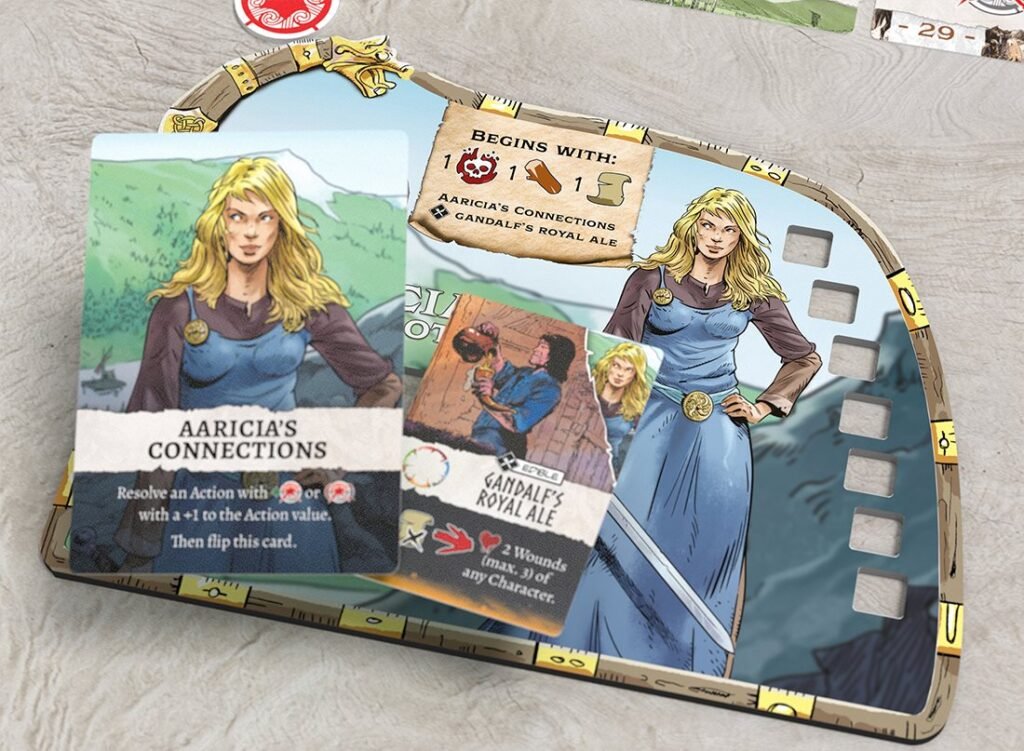
Let’s continue talking about Characters, differences between them and how immersive is Thorgal: The Board Game.
We have already dedicated one article to the player’s character development and how they gain experience. Today, I would like to return to the topic of player characters and discuss in more detail what exactly describes them in the game. But before I talk about their characteristics, abilities, and special features, a brief introduction to the subject of player characters in tabletop gaming.
When we play, we often have our own hero. Oh, of course, I know that we don’t embody any hero when playing Age of Steam, Ticket to Ride, or Catan. In Euro games, even when their theme suggests that we are someone, whether in Barrage (the company director) or Pillars of the Earth (the cathedral builder), it is basically an illustration, two sentences in the rulebook, and that’s it. Level I immersion!
It is more interesting in hybrid games, like Robinson Crusoe – everyone has their own hero, has their special abilities, and even has hit points! Still, there is no talk of role-playing or embodying, but players certainly feel the asymmetry and that they are playing someone. Let’s call this level II immersion in the role.
Going one step further in the direction of adventure games, here we play full-fledged, whether it’s Massive Darkness or Death May Die, we have our character cards, we have statistics, we have our figures, this is level III immersion here!
And the last one on the scale of embodying heroes, RPG games, whether it’s D&D, Call of Cthulhu, or any other – the player hero is the axis and foundation of the whole game. This is full immersion, this is level IV, the highest.
In the game of Thorgal, player heroes would fall somewhere between levels II and III on the immersion scale. If I were to vote, I would give it a 2.7.

Regarding what describes our hero and how it differs from the other characters in the game, firstly, there are attack dice and exploration tokens. This is the first element of hero diversity, some characters are better fighters, and others are better explorers, not only do they differ in their starting levels of these attributes, but also in their development path – for the experience gained in the game, they will ultimately achieve different levels in these abilities. Additionally, by gaining higher levels of exploration, they will unlock unique permanent perks for themselves.
Heroes also differ in their starting items, although this will quickly be able to be unified as one of the actions in the game is Building. Soon players can create new equipment, and although, for example, only one of them started the game with a bow, soon all the others will be able to arm themselves. Each hero also starts with a different set of starting resources – one of them will start with more knowledge of the area (Gossip), another with a big purse (Ore), and another with more knowledge of local myths and legends (Ancient Knowledge).
Heroes also differ from each other in their abilities. Each of them has one distinctive ability related to playing action cards. For example, Thorgal, as a persistent and unyielding person, so he ignores the rule that when performing an action, you must move your pawn to a different action. Kriss can cheat, so if she wants, she can use bonuses from pawns located to the right of her pawn – these are purely mechanical abilities, but nicely linked to the hero’s theme and story. Using these abilities is free, but once an ability is used, resources must be spent to unlock it again. Using them at the right moment is often crucial to a positive scenario outcome.
The last element is the Wound area – here, heroes do not differ in the number of hit points but in the shape of the entire area – in the first or second game, these nuances will be difficult to detect. Still, with each subsequent game, players will discover that the shape of this board significantly impacts the ability to survive battles and dangers!
This is how immersion at level 2.7 looks like! It is not a role-playing game, we don’t have a character sheet, a series of abilities, or different skills, but there are a few interesting, simple solutions that will make the gameplay with Kriss and Arricia different from the gameplay of Thorgal with Jolan, it will have a different vibe and atmosphere.
The only fundamental question remains – your first gameplay. Which character do you choose?
Author: Ignacy Trzewiczek
Find out more about Thorgal here.
 Polski
Polski English
English Deutsch
Deutsch



